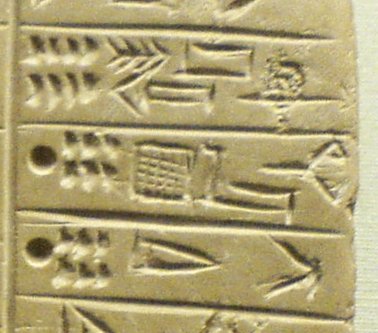You are here: Foswiki>Andypublic Web>CuneiformWriting (31 Jan 2007, andyp)Edit Attach
Cuneiform is a form of writing created with a wedge (cuneus) shaped tool. The first inscriptions discovered dates back to about 3000BC, and the most recent from the 1st Century AD. It originated in Ancient Mesopotamia and spread throughout the middle east as far as Egypt.
Originally used to write Sumerian, it was later used for many other languages, including Babylonian and Assyrian. It developed more than 600 characters, which could have several phonetic and symbolic meanings.
The Rosetta Stone for Cuneiform was the Behistun Inscription - found in Iran, it contained the same text (kingly boastings) in three languages
Old Persian, Assyrian, and Elamite. The decoding of the Persian in 1846 lead on to the cracking of the Assyrian and Elamite versions.
Many cuneiform representations of accounts and stock have been found, as have mathematical texts. The Babylonians used a sexigesimal system (base 60), presumably because 60 has a large number of divisors (1,2,3,4,5,6,10,12,15,20,30).
Using base 60 did make learning times-tables harder :-), so a written version was used.
Babylonian Numbers were written a bit like this
"<< VVV" = 2*10 + 3*1 = 23 "< VV << VVV" = (1*10+2*1)* 60 + (2*10 + 3*1) *1 = 12*60 + 23*1 = 743
- Numbers on a Land Purchase Tablet (~2400BC):

These show (from the top down), 8 "gur-sag-gal" of barley, 16 "pounds" of wool and 16 "quarts" of oil. In this example, a round mark has been used to represent "10", in the earlier, Summarian, style.
- http://en.wikipedia.org/wiki/Cuneiform_(script) - Encyclopedia article
- http://www.britannica.com/eb/article?eu=119411&tocid=53174 - Encyclopedia article
- http://www.math.tamu.edu/~don.allen/history/babylon/babylon.html - Babylonian Mathematics
- http://www.fordham.edu/halsall/ancient/2200akkad-father.html - The Advice of an Akkadian Father to His Son, c. 2200 BCE
| I | Attachment | Action |
Size | Date | Who | Comment |
|---|---|---|---|---|---|---|
| |
cuneiform_numbers_close_up.jpg | manage | 34 K | 30 Jan 2007 - 23:59 | Unknown User | Numbers on a Land Purchase Tablet (~2400BC) |
Edit | Attach | Print version | History: r4 < r3 < r2 < r1 | Backlinks | View wiki text | Edit wiki text | More topic actions
Topic revision: r4 - 31 Jan 2007, andyp
Favourite Pages
My Blog
Best Of Blog 2007
Best Of Blog 2005 Birmingham,
How to be Happy,
Influenza Pandemic,
Moseley Tornado,
Misty's Big Adventure,
Street Furniture Stickers,
Weird Internet Animations
Other People's Blogs
Birmingham Bloggers Danger! High Postage,
Parallax View,
Pete Ashton,
Silent Words Speak Loudest
Please don't ask for a sidebar link as a refusal often offends. Editorial Policy
My Blog
Best Of Blog 2007
Best Of Blog 2005 Birmingham,
How to be Happy,
Influenza Pandemic,
Moseley Tornado,
Misty's Big Adventure,
Street Furniture Stickers,
Weird Internet Animations
Other People's Blogs
Birmingham Bloggers Danger! High Postage,
Parallax View,
Pete Ashton,
Silent Words Speak Loudest
Please don't ask for a sidebar link as a refusal often offends. Editorial Policy
 Copyright © by the contributing authors. All material on this collaboration platform is the property of the contributing authors.
Copyright © by the contributing authors. All material on this collaboration platform is the property of the contributing authors. Ideas, requests, problems regarding Foswiki? Send feedback


